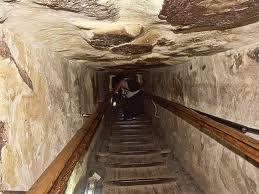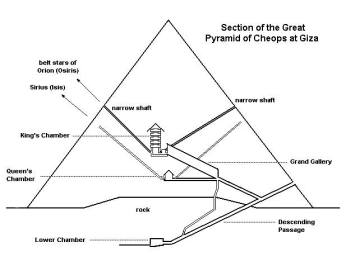The Egyptian pyramids and the mummy’s curse!
My visit to the pyramids of Giza
I recently fulfilled a lifetime dream of visiting the famous Pyramids of Giza, just to the south of Cairo, Egypt. These celebrated pyramids are among the Seven Wonders of the Ancient World, the oldest built more than 4500 years ago! Modern scholars and archaeologists have long been curious about these ancient tombs of the pharaohs. Out of the three pyramids, the most famous is the Great Pyramid of Khufu (Cheops), which was built by Pharaoh Khufu around 2560 BC.

Sam standing among the collosal, ancient limstone blocks that were used to build the Great Pyramid of Pharaoh Khufu. (Click on photos to enlarge.)
The Great Pyramid stands 137 meters (449 feet) high. Each side is oriented with one of the cardinal directions of the compass (north, south, east, and west). The Great Pyramid of Khufu is made up of two million blocks of limestone. Granite lines the entrances, the shafts and the chambers. The thousands of smooth white casing stones that beautified the sides of this pyramid, have long since been unfortunately removed, being used in other building projects.
I was pleasantly surprised when my Egyptian friends actually got permission for me to climb through the inner shafts of the Great Pyramid. This pyramid is equal in height to a modern 50-story skyscraper! For the better part of an hour, I was led upward through the narrow connecting shafts some 200 meters (656 feet) to the upper chamber of Khufu. Due to low ceilings in most of the shafts, one is forced to lean over while walking, literally crawling, in places, on hands and knees. It was a difficult climb, and I was drenched in sweat when I finally stood in the burial chamber of Pharaoh Khufu.
The Pyramid of Khafre (Chephren) is situated to the southwest of the Pyramid of Khufu. Although it appears to be taller than the Great Pyramid, as it stands on higher ground, this pyramid is actually smaller than that of Khufu. This pyramid was built by Khufu’s son Khafre.
The third pyramid, the Pyramid of Menkaure (Mycerinus), which stands some 67m (220ft) high, was started by Khafre’s son Menkaure.
In front of the Great Pyramid stands the Sphinx, a statue of a creature with the body of a lion and the head of a man. The Sphinx, which stands 20 meters (66 feet) high, and measuring about 73.5 meters (241 feet) long, was carved over 4500 years ago out of sandstone.
Archaeologists and historians marvel
Can you imagine one of our modern skyscrapers weathering 4500 years of harsh climatic conditions? Just how were these pyramids built? How have they stood the test of time?
Today’s scientists, historians and civil engineers stand in awe of the pyramids. They are continually developing theories as to just how the ancient Egyptian peoples could have carved and moved these millions of huge stones hundreds of miles from the far south to their Giza location and then haven assembled them into the pyramids.
When I was in graduate school, I remember reading the 1970 best-selling book by Erich von Däniken‘s titled Chariots of the Gods. The book theorized extraterrestrials interacting with early human life, passing on high-tech scientific information to undeveloped human civilizations in various parts of the world—one being the ancient kingdoms of the Egyptian pharaohs. (This theory was subsequently debunked by University of South Carolina professor Dr. Clifford Wilson in his 1972 sequel entitled Crash Go the Chariots.)
One of the best construction explanations I’ve found was published in the March 2008 issue of Science Daily.
The legendary curse of the pharaohs
Just two days after climbing through the Great Pyramid’s inner, narrow shafts leading to Khufu’s burial chamber, I ended up in a Jeddah, Saudi Arabia, hospital with a high temperature, swollen glands diagnosed with some mysterious, unknown virus. I was mainlined with some pretty powerful antibiotics for five days and then released to continue my recuperation at home. I have now fully recovered, but I couldn’t help but wonder about all the extraordinary rumors of pyramid curses that have circulated for centuries.
Movies and sensational Hollywood science fiction movies abound, encouraging the rumors—the classic being the 1944 horror film The Mummy’s Curse.
The idea of a mummy coming back to life from the dead, an essential part of many mummy curse legends, was developed in The Mummy! Or a Tale of the Twenty-Second Century, an early work combining science fiction and horror, written by Jane C. Loudon and published in 1827.
Louisa May Alcott was thought by Dominic Montserrat to have been the first to use a fully developed plot about the “mummy curse.”
Two other stories subsequently discovered by S. J. Wolfe, Robert Singerman and Jasmine Day–The Mummy’s Soul (Anonymous 1862) and After Three Thousand Years by Jane G. Austin in 1868–have similar plots. In both, a female mummy takes supernatural revenge upon her male counterpart.
Tutankhamun’s “curse”
The belief in a curse was brought to many people’s attention due to the mysterious deaths of several members of archaeologist Howard Carter‘s team while they were excavating the tomb of Tutankhamun (more commonly known as King Tut). The tomb was located far to the south in the Valley of the Kings and was opened by Carter and George Herbert, the Fifth Earl of Carnarvon (Lord Carnarvon) in 1922.
The famous Egyptologist James Henry Breasted, working with Carter soon after the first opening of the tomb, reported how Carter had sent a messenger on an errand to his house. When the man came near to Carter’s home he thought he heard a “faint, almost human cry.” On reaching the entrance he saw a cobra in a bird cage. (The cobra was the symbol of Egyptian monarchy.) Carter’s canary had died in the cobra’s mouth, and this fueled local rumors of a curse. An account of the incident was reported by the New York Times on 22 December 1922. The first of the “mysterious” deaths was that of Lord Carnarvon. Carnarvon had been bitten by a mosquito, and later cut the bite accidentally while shaving. It became infected and blood poisoning resulted.
Two weeks before Carnarvon died, Marie Corelli wrote an imaginative letter that was published in the New York World magazine, in which she quoted an obscure book that confidently asserted that “dire punishment” would follow any intrusion into a sealed tomb. A media frenzy followed, with reports that a curse had been found in the King’s tomb, though this was untrue.
The curse rumors were further fanned by Sir Arthur Conan Doyle, creator of Sherlock Holmes. In a film he suggested that Lord Carnarvon’s death had been caused by “elementals” created by Tutankhamun’s priests to guard the royal tomb, and this further fueled public curse frenzy. .
A newspaper report printed following Carnarvon’s death is also believed to have been responsible for the wording of the curse most frequently associated with Tutankhamun – “Death shall come on swift wings to him who disturbs the peace of the King.”
There is, though, a possible reasonable explanation for illness and even death resulting from noxious gases that are released when ancient tombs are opened. When Archaeologist Sami Gabra was working in tombs in the ibis-necropolis of Tuna el-Gebel, both he and his workers were seized by violent

Lord Carnarvon died six weeks after the opening of Tutankhamun’s tomb. His death resulted in many curse stories in the media.
headaches and shortness of breath. At first the workers feared of the ibis-headed god, Thoth. In reality, it was discovered that the cause was toxic vapors. When the tomb was fumigated, the crew returned to work..
Russians scale the Great Pyramid
A few months ago, Russian photographer Vadim Makhorov caused quite a stir when he published a set of stunning images captured from atop Egypt’s Great Pyramid. The photos, posted to Makhorov’s LiveJournal page, provide a rare view of one of the Seven Wonders of the Ancient World, though they’ve fueled a fair bit of controversy, as well.
Once the pyramid complex had closed to tourists, Makhorov and his two friends, Vitaliy Raskalov and Marat Dupri, staked out for nearly five hours, hiding themselves from Egypt’s armed guards. (Now if only I had been there to scale the pyramid with these guys!)
When they were certain the coast was clear, they embarked on the 481-foot climb to the top of the pyramids, where they captured incredible panoramic shots of the Giza Necropolis,. They were able to keep totally out of sight of the guards below.
According to Raskalov, the trio would have faced between one and three years in jail, had they been caught. Said Makhorov, “We didn’t want to insult anyone. We were just following our dream.”
Below are some of the photos Makhorov and his friends took.
Here’s an incredible video about the Great Pyramid of Giza:
Sources: Science Daily, The New York Times, New York World, Archaeology, The Pyramids of Egypt, BBC, The Verge, The Discovery Channel, National Geographic Magazine, galactic-server.net, en.wikipedia.org
-
Archives
- November 2018 (1)
- June 2018 (1)
- December 2016 (1)
- November 2016 (1)
- June 2016 (1)
- May 2016 (1)
- July 2015 (1)
- March 2015 (2)
- February 2015 (1)
- October 2014 (3)
- September 2014 (2)
- August 2014 (1)
-
Categories
-
RSS
Entries RSS
Comments RSS






